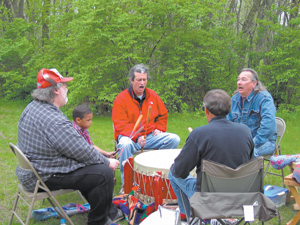CHIEF RICHARDVILLE HOUSE OPENS FOR SEASON

The events for May and June have been made possible with support from the Indiana Arts Commission and Arts United through their Regional Partnership Initiative.
On May 5, the Painted Turtle Drum & Singers presented traditional drumming and songs. It featured a large drum that has been named Mihsihkinaahkwa (“painted turtle”), named for the great Miami Chief Little Turtle. Jay Hartleroad is the current drum keeper. The “Painted Turtle Singers” presented a program of songs from the Miami tradition as well as other tribes including the Potawatomi. Although some of their songs contain words, many are known as “vocables,” a wordless tradition that allows inter-tribal gatherings in which representatives of different Indian nations speaking various languages can come together to sing.
The June 2 program will feature Sue Lester, a direct descendent of Francis Slocum and her husband, Deaf Man. Sewing since she was a child, Ms. Lester has been interested in the construction methods of historic Miami clothing since an early visit to the Cranbrook Institute near Detroit where she saw many Miami items, especially a wampum belt. “I was so in awe of being there and holding these items that had been in my family so many years ago, that I didn’t do a careful study.” But a few years later she returned and did a more thorough examination of the collection.
“Armed with the notes, measurements, and photos that I took there, I have recreated the Cranbrook blouse, a wrap skirt with simple ribbon work, and a wearing blanket. I plan to display some of the photos that I took along with other illustrations of Miami clothing. I will discuss these and my thoughts on the construction methods used. I will also have some examples of modern powwow regalia.”
Ms. Lester will be joined by Mary Tippmann of Columbia City and a Chief Richardville descendant, who will be wearing regalia that she and her grandmother have made. She will also demonstrate different styles of dance unique to the Miami. “I have been dancing since I could walk. I dance Fancy shawl dance, Traditional cloth, and buckskin.” Visitors will be encouraged to put their best foot forward and to try out some new dance moves.
Currently a student at Miami University (Oxford, Ohio) where she is majoring in health studies, Ms. Tippmann is 2007’s Head Lady for the Gathering of Great Lakes Nations Pow Wow and 2003’s Miami Maiden of Indiana.
The Focus Days for July and August will feature Eric Vosteen, one of the region’s leading authorities on ancient lifeways, demonstrating skills used by the earliest societies that resided in the Great Lakes area.
On July 7, he will explain flint-knapping, using sharp blows to shape stones and flints into useful tools “that can be used to accomplish basic everyday tasks such as cutting, sewing, drilling, and sawing sticks. It is not reasonable for beginners to expect to make arrowheads without a lot of practice, but some other tools can be made with little skill.” He will also demonstrate early pottery and how it was used to cook over a fire.
On August 4, Vosteen will demonstrate early hunting techniques and give visitors a lesson in throwing the deadly atlatl that became the scourge of many animals including Ice Age mastodons. “I will also discuss the importance of hunting animals to prehistoric cultures in the Great Lakes, and have examples of other animal harvesting methods and weapons like archery, deadfalls and other traps, fishing equipment, and more.”
On September 1, Dani Tippmann, a member of the Miami Tribe of Oklahoma will discuss wild plant uses. “The history of the Miami people can be traced through the plants that were used throughout time,” says Dani. She has spent much of her life talking to elders about plants and their usage within the Miami tribal culture. She will share some of her knowledge about plants for food, medicine and technological uses, best times to harvest, identification, common plants, plants that transfer easily to gardens and the Miami relationship with plants.
In October, the Miami Indian Alliance of Miami Indians (M.I.A.M.I.) will present programs on traditional cattail harvesting, weaving, and matting. Several hundred years ago, there was a large area known as the Black Swamp that extended from Fort Wayne all the way to Toledo. Native Americans discovered that the cattails that grew in this swamp could be woven into waterproof panels and used them in the construction of their homes as insulation against summer heat and winter cold. Laura Nagy, a member of The History Center’s Board of Directors and a descendant of Chief Richardville will be joined by other Miami in construction of a hut known as a wikiami in the Miami language.
That day will also feature the third annual Highflying History as skydivers deliver answers for a family-oriented trivia game that has been called “the most original piece of heritage education in northeast Indiana.”
The season ends the first weekend in November with the seventeenth annual Traders Days celebration featuring vendors, craftsmen and artists selling quality Native American items, including fine art, gourd work, beading, carved wood pieces, herbal supplements, corn husk dolls, Christmas ornaments, Native American shields, jewelry, clothing, feather work, homemade baked goods, and many more gift items just in time for holiday consideration.
Admission: $7 adults, $5 History Center members, students & seniors.
Parking is free and the first floor of the Chief Richardville House is handicap accessible.
- Celebrating 20 Years Of Community At The Stand - April 12, 2024
- First Positive Case Of Chronic Wasting Disease In Indiana - April 12, 2024
- Southwest Allen County Schools Embark On Major Tree Plantings - April 12, 2024


